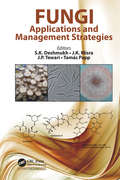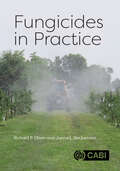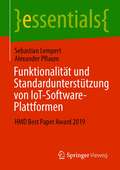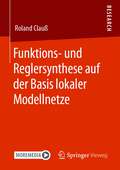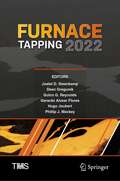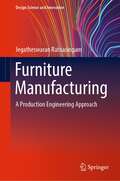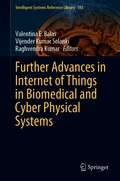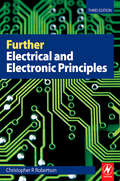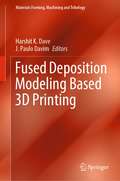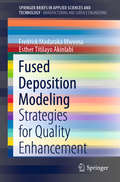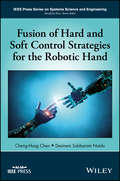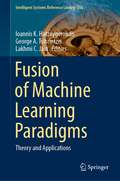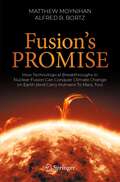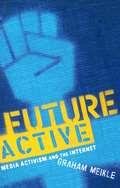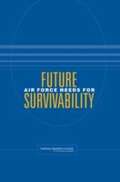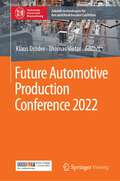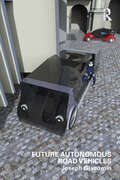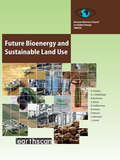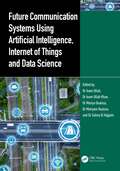- Table View
- List View
Fungi: Applications and Management Strategies (Progress in Mycological Research #3)
by Sunil K. Deshmukh J. K. Misra Jalpa P. Tewari Tamas PappThe book deals with the application of fungi and the strategic management of some plant pathogens. It covers fungal bioactive metabolites, with emphasis on those secondary metabolites that are produced by various endophytes, their pharmaceutical and agricultural uses, regulation of the metabolites, mycotoxins, nutritional value of mushrooms, prospecting of thermophilic and wood-rotting fungi, and fungi as myconano factories. Strategies for the management of some plant pathogenic fungi of rice and soybean have also been dealt with. Updated information for all these aspects has been presented and discussed in different chapters.
Fungicides in Crop Protection
by Richard Oliver H HewittPlant pathogenic fungi cause devastating damage to crop production worldwide. The growing global population necessitates reduced crop losses to improve food security, and the control of fungal plant pathogens is vital to help maintain food production. Providing a concise and balanced review of fungicides used in crop protection, this book describes the science of fungicide use, selection and resistance within the context of farming situations. Major updates and additions reflecting the emergence of two new classes of fungicides (strobilurins and SDHI) and the increased incidence of fungicide resistance are included in this new edition, which also discusses legislative requirements to reduce fungicide applications, and current trends in fungicide use.
Fungicides in Practice
by Richard P. Oliver Professor Janna L BeckermanThis is an up-to-date guide on the science and practice of disease control based on fungicides in horticulture and broad acre agriculture. It describes how conventional, organic and biological fungicides are discovered, how they work and how resistance evolves. Chapters on formulation, mode of action, mobility and application inform decisions about which fungicides to use, when to use them, and how to rotate (or tank-mix) them, to manage both plant disease and fungicide resistance. A chapter on experimental design of fungicide trials aids practitioners in designing their own trials to evaluate how effective products are for their plant disease problem. Based on the successful 2014 book of Fungicides in Crop Protection this edition has four entirely new chapters, and extensive updates to the other nine chapters. The contents include: · Fungicide markets, discovery and performance. · Modes of action and spectrum. · Biological crop protection, and organic cultivation. · Fungicide formulation, mobility and application. · Experimental design of fungicide trials and their analysis. · Fungicide resistance. · Legislation and regulation. Written for crop protection professionals and scientists, growers, agronomists and consultants, the book is also suitable for students of agriculture and agronomy.
Funktionalität und Standardunterstützung von IoT-Software-Plattformen: HMD Best Paper Award 2019 (essentials)
by Alexander Pflaum Sebastian LempertDerzeit konkurrieren über 450 Anbieter von IoT-Software-Plattformen miteinander, die Komplexität und die unterschiedlichen Eigenschaften dieser Plattformen führen zu einem intransparenten Markt. Folglich stehen Unternehmen, die eine IoT-Anwendung unter Weiternutzung ihrer bestehenden IT-Infrastruktur umsetzen wollen, vor der Herausforderung, die für diesen unternehmensspezifischen Anwendungsfall am besten geeignete IoT-Plattform aus einer Vielzahl von Kandidaten auszuwählen. Vor diesem Hintergrund werden Unternehmen durch das vorliegende Buch in die Lage versetzt, die Funktionalität und Standardunterstützung der am Markt verfügbaren IoT-Plattformen schnell zu verstehen und untereinander zu vergleichen.
Funktionelles Zusammenspiel von Gehirn und Herz: Von der Physiologie zur fortgeschrittenen Methodik der Signalverarbeitung und -modellierung
by Gaetano Valenza Vincenzo CatramboneDiese Monographie bietet einen systemübergreifenden Austausch und eine modalitätsübergreifende Untersuchung des Zusammenspiels von Gehirn und Herz. Das Zusammenspiel von Gehirn und Herz (Brain-Heart Interplay, BHI) ist ein hochgradig interdisziplinäres wissenschaftliches Thema, das sich von der Physiologie des zentralen/autonomen Nervensystems, insbesondere des zentral-autonomen Netzwerks, bis hin zu fortgeschrittener Signalverarbeitung und Modellierung zur Quantifizierung seiner Aktivität erstreckt. Motiviert durch klinische Befunde und unterstützt durch die neuesten Erkenntnisse der Neurophysiologie, untersucht diese Monographie zunächst die Definition grundlegender Quantifizierer des Zusammenspiels von Gehirn und Herz und geht dann zu fortgeschrittenen Methoden für die Bewertung von Gesundheits- und Krankheitszuständen über. Der nicht-invasive Einsatz von Techniken zur Überwachung des Gehirns, einschließlich des Elektroenzephalogramms und der funktionellen Magnetresonanztomographie, wird zusammen mit der Überwachung der Herzschlagdynamik durch Pulsoximeter und EKG-Signale beschrieben.Das Buch richtet sich insbesondere an biomedizinische Ingenieure und Mediziner mit Fachkenntnissen in Statistik und/oder Signalverarbeitung. Aber auch Forscher in den Bereichen Kardiologie, Neurologie, Psychiatrie und Neurowissenschaften im Allgemeinen können sich für dieses Buch interessieren.
Funktions- und Reglersynthese auf der Basis lokaler Modellnetze
by Roland ClaußDer Autor untersucht eine Methode zur Realisierung modellbasierter Funktionsentwicklung im industriellen Umfeld und der damit einhergehenden zeitlichen Ristrektionen eines Entwicklungsprojekts. Der Schwerpunkt liegt dabei auf der Systemidentifikation (datenbasierten Modellbildung) statischer oder dynamischer nichtlinearer Systeme, die auf der Basis lokaler Modellnetze realisiert wird. Für die Strukturoptimierung der Modellnetze werden zwei neue Ansätze vorgestellt, die eine hohe Effizienz und Genauigkeit bei der Modellbildung aufweisen. Der Autor integriert im nächsten Schritt die identifizierten Modelle in verschiedene beschränkte prädiktive Mehrgrößenregler eines Wärmepumpensystems und zeigt eine Strategie auf, um das System im geschlossenen Regelkreis effizient auszulegen und zu validieren.
Furan Polymers and their Reactions
by Alessandro Gandini Talita M. LacerdaFURAN POLYMERS AND THEIR REACTIONS Understand furan polymers and their roles in industrial production Furans are platform chemicals from biomass which have a range of functions in the production of solvents, biofuels, and monomers for industrial polymer synthesis. As the search for sustainable industrial processes makes biomass resources ever more vital, a more detailed understanding of these compounds and their industrial uses has never been more critical. Furan Polymers and their Reactions surveys these crucial compounds and their contributions to polymer synthesis. It discusses the biorefinery of furans, identifies furfural and 5-hydroxymethyl furfural as the key furan monomer precursors for different polymer synthetic processes, and analyzes all the major reactions furans undergo during these processes and the structures, properties and applications of the ensuing materials. The results are a vital contribution to the growing field of renewable industry. Furan Polymers and their Reactions readers will also find: Detailed analysis of key polymerization reactions such as the Diels-Adler reaction, chain-growth and step-growth polymerizations, as well as the chemical modifications of some of these polymers. An authorial team with decades of combined experience in furan chemistry and polymer synthesis Furan Polymers and their Reactions is an essential resource for researchers and professionals in industrial engineering, polymer science, and biotechnology, as well as for any industry professionals working with platform chemicals or polymer synthesis.
Furnace Tapping 2022 (The Minerals, Metals & Materials Series)
by Dean Gregurek Joalet D. Steenkamp Quinn G. Reynolds Gerardo Alvear Flores Hugo Joubert Phillip J. MackeyNo pyrometallurgical smelter can operate without some form of tapping system. It is the one thing all smelters have in common. This collection discusses this meeting point of the science, technology, and skill involved in this process. The tap-hole design process includes a set of design criteria, which need to be revised as the results of laboratory, computational fluid dynamics (CFD), and time-and-motion studies become available. The tap-hole life cycle is considered in this volume, with authors addressing the requirements for installation and operability as well as for maintenance. Matters such as online monitoring of the tap-hole wear, handling of liquid products, and extraction of fumes are all discussed. Although much has been done to make the tapping process as automatic as possible, tapping of smelters cannot be done without labor. Tap floor operators work in harsh environments where safety is of utmost importance. Selection of suitable personnel and intensive training is required and is discussed in this collection.
Furniture Manufacturing: A Production Engineering Approach (Design Science and Innovation)
by Jegatheswaran RatnasingamThis volume covers all aspects of furniture manufacturing from a production engineering perspective. It takes a step-by-step pedagogical approach, dwelling on details which must be understood at every process, as the furniture makes its way through the factory shop floor. The content highlights the global industry, and discusses furniture design and manufacturing systems. The chapters also discuss every stage of the manufacturing process until the finished product is packaged. There is also emphasis on strength design of furniture, furniture testing, environmental compliance, and automation. The contents also discuss the optimization of furniture manufacturing through a mathematical approach and highlights the current global trends impacting the furniture manufacturing industry, especially the circular economy and Industry 4.0. This volume will a useful resource to those in academia and industry.^
Further Advances in Internet of Things in Biomedical and Cyber Physical Systems (Intelligent Systems Reference Library #193)
by Raghvendra Kumar Valentina E. Balas Vijender Kumar SolankiThis book covers the further advances in the field of the Internet of things, biomedical engineering and cyber physical system with recent applications. It is covering the various real-time, offline applications, and case studies in the field of recent technologies and case studies of the Internet of things, biomedical engineering and cyber physical system with recent technology trends. In the twenty-first century, the automation and management of data are vital, in that, the role of the Internet of things proving the potential support. The book is consisting the excellent work of researchers and academician who are working in the domain of emerging technologies, e.g., Internet of things, biomedical engineering and cyber physical system. The chapters cover the major achievements by solving and suggesting many unsolved problems, which am sure to be going to prove a strong support in industries towards automation goal using of the Internet of things, biomedical engineering and cyber physical system.
Further Electrical and Electronic Principles
by C R RobertsonFurther Electrical and Electronic Principles is a core text for pre-degree courses in electrical and electronic engineering courses. The coverage of this new edition has been brought in line with the specialist unit 'Further Electrical Principles' of the 2007 BTEC National Engineering specification from Edexcel. As the book follows a logical topic progression rather than a particular syllabus, it is also suitable for other Level 3 students on vocational courses such as Vocational AS/A Level, City & Guilds courses and NVQs.More advanced material has also been included, making this text also suitable for HNC/HND and foundation degree courses.Each chapter starts with learning outcomes tied to the syllabus. All theory is explained in detail and backed up with numerous worked examples. Students can test their understanding with end of chapter assignment questions for which answers are provided. The book also includes suggested practical assignments and handy summaries of equations. In this new edition, the layout has been improved and colour has been added to make the book more accessible for students.The textbook is supported with a free companion website featuring supplementary worked examples and additional chapters.http://books.elsevier.com/companions/9780750687478
Fused Deposition Modeling Based 3D Printing (Materials Forming, Machining and Tribology)
by J. Paulo Davim Harshit K. DaveThis book covers 3D printing activities by fused deposition modeling process. The two introductory chapters discuss the principle, types of machines and raw materials, process parameters, defects, design variations and simulation methods. Six chapters are devoted to experimental work related to process improvement, mechanical testing and characterization of the process, followed by three chapters on post-processing of 3D printed components and two chapters addressing sustainability concerns. Seven chapters discuss various applications including composites, external medical devices, drug delivery system, orthotic inserts, watertight components and 4D printing using FDM process. Finally, six chapters are dedicated to the study on modeling and optimization of FDM process using computational models, evolutionary algorithms, machine learning, metaheuristic approaches and optimization of layout and tool path.
Fused Deposition Modeling: Strategies for Quality Enhancement (SpringerBriefs in Applied Sciences and Technology)
by Esther Titilayo Akinlabi Fredrick Madaraka MwemaIn this book, fused deposition modeling (FDM) is described with focus on product quality control and enhancement. The book begins by introducing the basics of FDM and its associated process parameters. Then, strategies for quality control and enhancement are described using case studies of both original results by the authors and from published literature. Resolution and print orientation, multi-objective optimizations and surface engineering are identified and discussed as the strategies for enhancing the quality of FDM products in this book.
Fusion 360 for Makers: Design Your Own Digital Models for 3D Printing and CNC Fabrication
by Lydia Sloan ClineLearn how to use Autodesk Fusion 360 to digitally model your own original projects for a 3D printer or a CNC device. Fusion 360 software lets you design, analyze, and print your ideas. Free to students and small businesses alike, it offers solid, surface, organic, direct, and parametric modeling capabilities.Fusion 360 for Makers is written for beginners to 3D modeling software by an experienced teacher. It will get you up and running quickly with the goal of creating models for 3D printing and CNC fabrication.Inside Fusion 360 for Makers, you'll find:Eight easy-to-understand tutorials that provide a solid foundation in Fusion 360 fundamentalsDIY projects that are explained with step-by-step instructions and color photosProjects that have been real-world tested, covering the most common problems and solutionsStand-alone projects, allowing you to skip to ones of interest without having to work through all the preceding projects firstDesign from scratch or edit downloaded designs. Fusion 360 is an appropriate tool for beginners and experienced makers.
Fusion 360 for Makers: Design Your Own Digital Models for 3D Printing and CNC Fabrication
by Lydia Sloan ClineLearn how to use Autodesk Fusion 360 to digitally model your own original projects for a 3D printer or a CNC device.
Fusion of Hard and Soft Control Strategies for the Robotic Hand
by Cheng-Hung Chen Desineni Subbaram NaiduAn in-depth review of hybrid control techniques for smart prosthetic hand technology by two of the world’s pioneering experts in the field Long considered the stuff of science fiction, a prosthetic hand capable of fully replicating all of that appendage’s various functions is closer to becoming reality than ever before. This book provides a comprehensive report on exciting recent developments in hybrid control techniques—one of the most crucial hurdles to be overcome in creating smart prosthetic hands. Coauthored by two of the world’s foremost pioneering experts in the field, Fusion of Hard and Soft Control Strategies for Robotic Hand treats robotic hands for multiple applications. Itbegins withan overview of advances in main control techniques that have been made over the past decade before addressing the military context for affordable robotic hand technology with tactile and/or proprioceptive feedback for hand amputees. Kinematics, homogeneous transformations, inverse and differential kinematics, trajectory planning, and dynamic models of two-link thumb and three-link index finger are discussed in detail. The remainder of the book is devoted to the most promising soft computing techniques, particle swarm optimization techniques, and strategies combining hard and soft controls. In addition, the book: Includes a report on exciting new developments in prosthetic/robotic hand technology, with an emphasis on the fusion of hard and soft control strategies Covers both prosthetic and non-prosthetic hand designs for everything from routine human operations, robotic surgery, and repair and maintenance, to hazardous materials handling, space applications, explosives disposal, and more Provides a comprehensive overview of five-fingered robotic hand technology kinematics, dynamics, and control Features detailed coverage of important recent developments in neuroprosthetics Fusion of Hard and Soft Control Strategies for Robotic Hand is a must-read for researchers in control engineering, robotic engineering, biomedical sciences and engineering, and rehabilitation engineering.
Fusion of Machine Learning Paradigms: Theory and Applications (Intelligent Systems Reference Library #236)
by Lakhmi C. Jain George A. Tsihrintzis Ioannis K. HatzilygeroudisThis book aims at updating the relevant computer science-related research communities, including professors, researchers, scientists, engineers and students, as well as the general reader from other disciplines, on the most recent advances in applications of methods based on Fusing Machine Learning Paradigms. Integrated or Hybrid Machine Learning methodologies combine together two or more Machine Learning approaches achieving higher performance and better efficiency when compared to those of their constituent components and promising major impact in science, technology and the society. The book consists of an editorial note and an additional eight chapters and is organized into two parts, namely: (i) Recent Application Areas of Fusion of Machine Learning Paradigms and (ii) Applications that can clearly benefit from Fusion of Machine Learning Paradigms. This book is directed toward professors, researchers, scientists, engineers and students in Machine Learning-related disciplines, as the hybridism presented, and the case studies described provide researchers with successful approaches and initiatives to efficiently address complex classification or regression problems. It is also directed toward readers who come from other disciplines, including Engineering, Medicine or Education Sciences, and are interested in becoming versed in some of the most recent Machine Learning-based technologies. Extensive lists of bibliographic references at the end of each chapter guide the readers to probe further into the application areas of interest to them.
Fusion's Promise: How Technological Breakthroughs in Nuclear Fusion Can Conquer Climate Change on Earth (And Carry Humans To Mars, Too)
by Alfred B. Bortz Matthew MoynihanFor over 60 years, scientists and engineers have been trying to crack a seemingly intractable problem: how to build practical devices that exploit nuclear fusion. Access to electricity has facilitated a standard of living that was previously unimaginable, but as the world’s population grows and developing nations increasingly reap the benefits of electrification, we face a serious global problem: burning fossil fuels currently produces about eighty percent of the world's energy, but it produces a greenhouse effect that traps outgoing infrared radiation and warms the planet, risking dire environmental consequences unless we reduce our fossil fuel consumption to near zero in the coming decades. Nuclear fusion, the energy-producing process in the sun and stars, could provide the answer: if it can be successfully harnessed here on Earth, it will produce electricity with near-zero CO2 byproduct by using the nuclei in water as its main fuel. The principles behind fusion are understood, but the technology is far from being fully realized, and governments, universities, and venture capitalists are pumping vast amounts of money into many ideas, some highly speculative, that could lead to functioning fusion reactors. This book puts all of these attempts together in one place, providing clear explanations for readers who are interested in new energy technologies, including those with no formal training in science or engineering. For each of the many approaches to fusion, the reader will learn who pioneered the approach, how the concept works in plain English, how experimental tests were engineered, the future prospects, and comparison with other approaches. From long-established fusion technologies to emerging and exotic methods, the reader will learn all about the idea that could eventually constitute the single greatest engineering advance in human history.
Future Active: Media Activism and the Internet (Media.culture Ser.)
by Graham MeikleFirst Published in 2003. Routledge is an imprint of Taylor & Francis, an informa company.
Future Air Force Needs For Survivability
by National Research Council of the National AcademiesA key technical issue for future Air Force systems is to improve their ability to survive. Increased use of stealth technology is proposed by many to be the major element in efforts to enhance survivability for future systems. Others, however, suggest that the high cost and maintenance required of stealth technology make increased speed potentially more productive. To help address this issue, the Air Force asked the NRC to investigate combinations of speed and stealth that would provide U.S. aircraft with a high survival capability in the 2018 period, and to identify changes in R&D plans to enable such aircraft. This report presents a review of stealth technology development; a discussion of possible future missions and threats; an analysis of the technical feasibility for achieving various levels of stealth and different speeds by 2018 and of relevant near-term R&D needs and priorities; and observations about the utility of speed and stealth trade-offs against evolving threats.
Future Automotive Production Conference 2022 (Zukunftstechnologien für den multifunktionalen Leichtbau)
by Thomas Vietor Klaus DröderThis book comprises the proceedings of the conference “Future Automotive Production 2022”, which took place in Wolfsburg. The conference focused on hybrid lightweight design, which is characterized by the combination of different materials with the aim of improving properties and reducing weight. In particular, production technologies for hybrid lightweight design were discussed, new evaluation methods for the ecological assessment of hybrid components were presented and future-oriented approaches motivated by nature for the development of components, assemblies and systems were introduced.Lightweight design is a key technology for the development of sustainable and resource-efficient mobility concepts. Vehicle manufacturers operate in an area of conflict between customer requirements, competition and legislation. Material hybrid structures, which combine the advantages of different materials, have a high potential for reducing weight, while simultaneously expanding component functionality. The future, efficient use of function-integrated hybrid structures in vehicle design requires innovations and constant developments in vehicle and production technology. There is a great demand, especially with regard to new methods and technologies, for "affordable" lightweight construction in large-scale production, taking into account the increasing requirements with regard to variant diversity, safety and quality.
Future Autonomous Road Vehicles
by Joseph GiacominThis book provides a comprehensive overview of the past, present and future of autonomous road vehicles for professionals and students.Split into three parts, the first section of the book brings together the key historical developments in autonomous road vehicle design and the primary explorations of the design possibilities from science fiction. This historical analysis draws upon significant test vehicles from history and explores their roles as landmarks in the evolution of the field. In addition, it also reviews the history of science fiction and outlines the key speculations about autonomous road vehicles which emerged from that world. In the second section of the book, Joseph Giacomin introduces five of the most popular future-facing speculative approaches used by designers. In doing so, he identifies the major user-facing challenges which affect ideation, product design, service design and business modelling. In the final part, science fiction prototyping is identified as the speculative approach best suited to autonomous road vehicle application. Connecting theory with practice, Giacomin provides examples of sixteen science fiction prototypes, which cover a comprehensive range of physical, psychological, sociological and ethical design challenges.Written as an accessible guide for design practitioners and students, this book will be of use to those interested in the psychological, sociological and ethical factors involved in automotive design, human-centred design, industrial design and technology.
Future Bioenergy and Sustainable Land Use
by Renate SchubertBecause of the major opportunities and risks associated with it, and the complexity of the subject, bioenergy policy has in a short time become a challenging political task for regulators and planners – a task that can only be accomplished through worldwide cooperation and the creation of an international framework. This book's central message is that the sustainable potential of bioenergy, which can be tapped all over the world, should be utilized – provided that threats to sustainability are avoided. In particular, the use of bioenergy must not endanger food security or the goals of nature conservation and climate change mitigation.
Future Communication Systems Using Artificial Intelligence, Internet of Things and Data Science
by Dr Inam UllahFuture Communication Systems Using Artificial Intelligence, Internet of Things and Data Science mainly focuses on the techniques of artificial intelligence (AI), Internet of Things (IoT) and data science for future communications systems.The goal of AI, IoT and data science for future communications systems is to create a venue for industry and academics to collaborate on the development of network and system solutions based on data science, AI and IoT. Recent breakthroughs in IoT, mobile and fixed communications and computation have paved the way for a data‑centric society of the future. New applications are increasingly reliant on machine‑to‑machine connections, resulting in unusual workloads and the need for more efficient and dependable infrastructures. Such a wide range of traffic workloads and applications will necessitate dynamic and highly adaptive network environments capable of self‑optimization for the task at hand while ensuring high dependability and ultra‑low latency.Networking devices, sensors, agents, meters and smart vehicles/systems generate massive amounts of data, necessitating new levels of security, performance and dependability. Such complications necessitate the development of new tools and approaches for providing successful services, management and operation. Predictive network analytics will play a critical role in insight generation, process automation required for adapting and scaling to new demands, resolving issues before they impact operational performance (e.g., preventing network failures and anticipating capacity requirements) and overall network decision‑making. To increase user experience and service quality, data mining and analytic techniques for inferring quality of experience (QoE) signals are required.AI, IoT, machine learning, reinforcement learning and network data analytics innovations open new possibilities in areas such as channel modeling and estimation, cognitive communications, interference alignment, mobility management, resource allocation, network control and management, network tomography, multi‑agent systems and network ultra‑broadband deployment prioritization. These new analytic platforms will aid in the transformation of our networks and user experience. Future networks will enable unparalleled automation and optimization by intelligently gathering, analyzing, learning and controlling huge volumes of information.
Future Communication Technology and Engineering: Proceedings of the 2014 International Conference on Future Communication Technology and Engineering (FCTE 2014), Shenzhen, China, 16-17 November 2014
by Kennis ChanThis volume contains the papers presented at the 2014 International Conference on Future Communication Technology and Engineering (FCTE2014), taking place in Shenzhen, China from 16-17 November 2014. Communication technologies are developing quickly and there are more possibilities for future communication technologies provided by the achievements made, rather than limitations. At the convention, innovative and inspiring ideas were presented; certain controversial topics were discussed (e.g. what are the most efficient/convenient methods for information communication) and what is the most probable prospect for future communication technology. It is difficult to make any definite conclusions from these presentations and discussions, but the desire and drive for improvement and development shown by the participants/authors are surely remarkable and respectable. In this book, 70 papers are included, chosen from hundreds of submissions contributed by scientists from various countries and regions, after careful reading and discussing by a team of reviewers. These papers cover almost every possible aspect of communication technology; including communication systems, automation and control engineering, electrical engineering, AI algorithms, signal processing, data mining, and knowledge-based systems.
